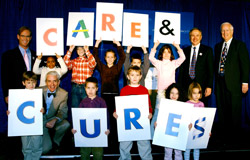(Republished with permission from the St. Louis Post-Dispatch. This article originally ran in the Science & Medicine section on Thursday, Jan. 26, 2006.)
By Tina Hesman
St. Louis Post-Dispatch

One of the largest non-profit fundraising campaigns in St. Louis history aims to find cures for four childhood diseases.
St. Louis Children’s Hospital and Washington University announced Wednesday that they will spend $120 million to research congenital heart disease, pediatric brain cancer, lung diseases and defects of the muscles and skeleton.
The project, called the Children’s Discovery Institute, will include scientists from the Washington University medical school, the Genome Sequencing Center and several departments in the university, including genetics, engineering, physics and chemistry.
The team approach is a new strategy. The National Institutes of Health recently tried a similar plan in a small number of its research areas. The Children’s Discovery Institute will be the first to build teams of scientists from many disciplines to tackle pediatric diseases, said Lee F. Fetter, president and senior executive of St. Louis Children’s Hospital.
The research money comes mostly from the $125 million “Care and Cures” fundraising campaign, sponsored by the philanthropic Children’s Hospital Foundation. That campaign is raising money for both the institute and a hospital expansion program.
It is an unusual kind of partnership to have a hospital raise money to pay for research at a university, said Dr. Jonathan Gitlin, director of genetics and genomic medicine at St. Louis Children’s Hospital and professor of pediatrics at Washington University School of Medicine.
The effort has been raising money for the past three years and is slated to continue into 2007. So far, the campaign has collected more than $100 million, Fetter said at a press conference Wednesday.
The funds include a $20 million donation from the McDonnell family to establish the McDonnell Children’s Cancer Center, a virtual institute to study brain cancer.
Brain cancer is the second most common cancer in children and one of the most deadly, said Dr. Larry J. Shapiro, Dean of the Washington University School of Medicine.
Leukemia is the most common type of solid tumor in children. Over the past several decades, cure rates for some types of leukemia have risen to 90 percent or better, Shapiro said.
But brain cancer, which strikes more than 3,000 children each year, is a different story. The prognosis for a child with a brain tumor is no different today than it was 30 years ago when the McDonnell family lost a daughter to cancer of the nervous system, Shapiro said. The disease is almost always a death sentence, and children who do survive often have severe physical and learning disabilities.
The details of the institute have yet to be worked out. A 14-member board, including Shapiro and Fetter as ex-officio members, will oversee distribution of funds. The board will meet for the first time on Feb. 2.
The institute expects to award money to research teams later this year.
thesman@post-dispatch.com 314-340-8325
Copyright 2006 St. Louis Post-Dispatch, Inc.